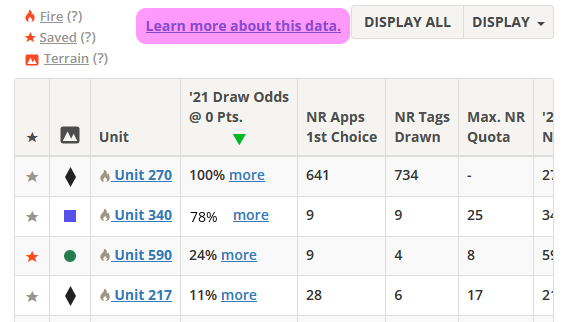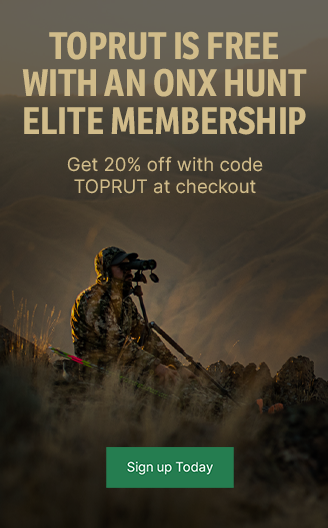Demand is up, draw odds are getting worse and true over the counter (OTC) hunt opportunities are slowly declining year over year. Now more than ever, having a multi-state application strategy is a necessity if you are hoping to consistently draw tags annually as a nonresident. As the 2022 application windows start to open up all across the west there is no better time than now to think about your plan for this year and how to set yourself up for success in the years to come.
Here are 4 tips to consider as the application season gets underway:
Of these, the short term planning is the most important for consistency. If your short term planning is solid you will do fine even if you turn out to be extremely unlucky drawing tags in your medium and long term buckets.
Hunts in the short term category can be drawn with 0 - 4 points, or have odds > 20% in random draws. Find 4 or 5 different hunts across states/species that interest you with the goal of cycling through them as much as possible. As an example, if you are consistently applying for 2 hunts in your short term group that have at least 20% random odds, in 3 years your probability of drawing one of these tags is at minimum about 74%. Combine that with 2-3 other hunts on your list that can be predictably drawn with less than 4 preference points and you're in business.
Medium term hunts are in the 5 - 9 point range, or have random draw odds somewhere between 8 and 20%. Tags drawn with points are obviously better for predictability and planning, but if your budget allows you should include some tags targeted in the random draws as well. If you consistenly apply annually for 2 tags with 8% random odds, in 6 years your probabilty of drawing one is about 65%. In 8 years it's almost 75%. The hope is that you can fill a gap or hunt a year without burning one of the tags in your short term hunt cycle.
Long term hunts require 10+ points, or have random draw odds < 8%. Nearly all ram, bull moose and mountain goat hunts easily fall into this category as well as most "trophy" units for elk, deer and antelope. Point creep is a killer for these type of hunts even for applicants who currently have double digit point totals. Drawing these types of tags are increasingly about just getting lucky, but when/if you hit and get to "cut the line" it can provide some unforgettable memories. It takes about 9 years to have a 50/50 chance of drawing a 4% random odds tag if you apply for 2 of them every year. But someone has to get lucky!
Every state big game draw is unique and it is not easy to keep it all straight each application season. There are different point systems, quota splits, draw procedures, hybrid draws - and on and on. It can be quite confusing, especially if you are new to the game.
To help you keep track of it all, Toprut provides an abbreviated cheat sheet of sorts for each state/species. Near the top of our List View be sure to utilize the "Learn more about this data." link to remind you of the draw specifics:

If you're familiar with applying out west you may argue there are still plenty of easily obtainable tags. The obvious example is Colorado where there are still an abundance of OTC elk areas and a significant number of hunt codes that can be drawn with 1 or fewer points. But as tags everywhere else become harder to draw, the pressure on these hunts increases and the quality of the experience declines. When things reach a certain level, state wildlife agencies tend to pull back on opportunity (for example, Colorado is currently considering going from OTC to limited archery elk licenses in Game Management Units 14, 214, 80, and 81 beginning in 2022).
If recent demand trends continue it may be increasingly difficult to maintain a short term tag strategy that is sustainable. Start thinking about a backup plan now if OTC is your primary annual plan. And if it turns out that we've already seen peak demand for public land western hunting then you'll still have gained a couple of future options to help fill in your hunt calendar.
Specifically, keep a close eye on the hunts in your short term plan. The "best" current options are also the hunts that will most likely see their draw odds decline in the future. For example, the nonresident general elk tag in Wyoming was a sure candidate for your short term plan just 2 years ago. But given how things have gone that hunt may need to slide into your medium term group at this point - depending on how you apply.
In addition, be aware of any major changes happening with state regulations, tag quotas or license allocations. The state agencies themselves are primary sources of information and in today's world it's fairly easy to be alerted about such things via online platforms like social media, public forums and streaming video. Take a few minutes to understand any proposed or implemented changes and think about how it may impact your overall plan.
Things have gotten tough in recent years, but it's time to make your own luck with some intentional and deliberate planning. Let everyone else complain about increased demand and moan about the draw odds - there are still plenty of options out there for the thoughtful hunter. The search for possible hunts you could do in 2024 and beyond should be an integral part of your 2022 research.
